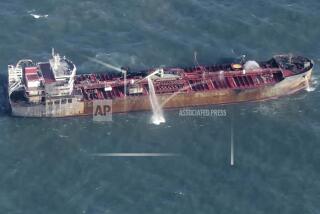Depth of Water Is Key as Tanker Spill Trial Opens
- Share via
SANTA ANA — The captain of an oil tanker ignored important data about ocean depth and tried to berth his ship at an offshore terminal, running it aground and causing the 1990 oil spill that fouled 15 miles of Orange County beaches, an attorney said Tuesday.
“The ship hit so hard that it brought people [on board] to their knees,” Michael Leslie, a private attorney representing state and local governments, said. “They could see the deck plates ripple.”
Leslie spoke during opening arguments of a jury trial in Orange County Superior Court in which state and local governments are seeking to prove $20 million in damages against the American Trading Transportation Co., which owned and operated the tanker American Trader. However, about $11 million of those damages already has been collected in settlements from other companies involved in the spill, leaving American Trader potentially liable for the rest.
Leslie’s account of the accident differed sharply from that of David Woolley, an attorney representing the shipping company. Describing Capt. A.R. LeWare as a “careful man,” Woolley blamed the accident on misinformation provided by a pilot whose job it was to guide the American Trader in to the offshore terminal.
“There is a mutual relationship between the pilot and the captain,” Woolley said. “In the matter of sailing the ship, the captain is the expert. But in the matter of the port, the pilot is the expert. If you ask the pilot and he says you are safe, you believe that you are safe.”
At issue on Feb. 7, 1990, was the depth of the water about a mile off Huntington Beach, where the American Trader was attempting to berth with a full load of oil. According to Leslie, the depth was about 51 feet, a fact he said was recorded in various documents available to the captain, which he chose to ignore.
But because the water was shallower than believed, the tanker ran aground, settling on its anchor and rupturing its hull.
However, Woolley blamed the spill on pilot John Keon, who approved the berthing, believing the depth to be 56 feet.
“LeWare] didn’t just blindly go in there,” Woolley said. “He got permission” from Keon, who was standing next to him on the bridge.
The two attorneys differed on other major points as well.
The state maintains that 400,000 gallons of oil leaked out of the ruptured tanker. But Woolley said the American Trading Transportation Co. has since recalculated the spill at about 208,000 gallons. The distinction is important because the amount in damages for which the plaintiffs are asking was, in part, determined by the number of gallons spilled.
And while Leslie characterized the shipping company’s cleanup efforts after the spill as woefully inadequate, Woolley attacked the state’s estimates on the number of people deprived of recreational opportunities as a result of the disaster.
In addition to killing more than 1,000 birds, the oil spill caused many of Orange County’s major beaches to be closed for six weeks while the oil was cleaned up.
In a suit filed in January 1991, state and local officials sought millions of dollars in damages from a host of companies deemed responsible for the spill, including American Trading and BP America, which owned the oil and chartered the tanker.
Settlements totaling $7 million with BP America and a petroleum industry fund were reached in 1995. The money was earmarked for restoring and protecting wildlife habitat, as well as pollution-monitoring projects and response costs. A separate, $4.15-million settlement with Golden West Refining Co.--the company that operated the offshore terminal where the tanker attempted to moor--was announced in 1996.
However, American Trading has declined to settle, setting the stage for the trial before Judge William F. McDonald that could mark the final chapter in the 7-year legal saga.
Leslie said the $20-million damage claim was calculated through a formula applying a specific penalty for each gallon of oil spilled. The formula also places a specific value on the temporary loss of recreational opportunities to the thousands of people who might have gone to the beaches had they not been closed.
If the state wins the case, the money--plus as much as $5 million in interest--will go into a fund to be used by the various cities and agencies affected for the enhancement of beach recreation in Orange County.
Opening arguments are scheduled to resume Thursday in the trial, which is expected to last until early December.
More to Read
Sign up for Essential California
The most important California stories and recommendations in your inbox every morning.
You may occasionally receive promotional content from the Los Angeles Times.












